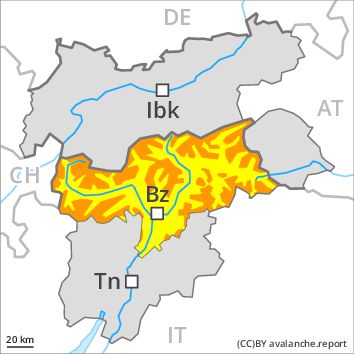Regions
Sexten Dolomites, Eastern Pfunderer Mountains, Durreck Range, Val Müstair Alps, Western Rieserferner Mountains, Langtaufers, Western Deferegger Alps, Schnals Ridge, Ortler Range, Southern Stubai Alps, Ulten Valley, Southern Zillertal Alps and High Tauern, Eastern Nonsberger Alps, Saldurn-Mastaun Ridge, Northern Dolomites of Fiemme, Texel Mountains, Gröden Dolomites, Sarntal Alps, Prags Dolomites, Western Pfunderer Mountains

Danger level
Avalanche Problem
Wind-drifted snow above the treeline, N-NE-E-SE-S-SW-W-NW
Gliding snow above 2400m, N-NE-E-SE-S-SW-W-NW

The wind slabs represent the main danger.
The current avalanche situation calls for experience in the assessment of avalanche danger and careful route selection. Great caution and restraint are advisable. The more recent wind slabs are extensive and can in some cases be released easily. Single winter sport participants can release avalanches very easily, in the regions exposed to heavier precipitation in particular on wind-loaded slopes and. Especially below approximately 2400 m small and medium-sized gliding avalanches are possible.
Snowpack
The wind slabs have formed in particular in the regions exposed to precipitation and generally at high altitudes. They are extensive and prone to triggering. In some cases the wind slabs have bonded still only poorly with the old snowpack. Faceted weak layers exist in the old snowpack in particular adjacent to ridgelines. The old snowpack will be moist below approximately 2200 m. As a consequence of the strong to storm force northwesterly wind the prevalence and size of the avalanche prone locations will increase on Monday.
Tendency
Gradual increase in danger of dry avalanches as a consequence of fresh snow and strong wind. The northwesterly wind will transport the fresh and old snow. Wind slabs represent the main danger. There is a danger of gliding avalanches, in particular in the regions with a lot of snow in particular below approximately 2200 m.